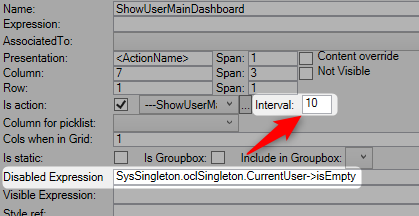Periodic action
No edit summary |
No edit summary |
||
| Line 1: | Line 1: | ||
A periodic action is a | A periodic action is a ViewModel action that runs automatically over and over again until the Disabled expression is True. | ||
In the | In the ViewModel editor: | ||
[[File:Example of periodic action.png|none|thumb|419x419px]] | [[File:Example of periodic action.png|none|thumb|419x419px]] | ||
You typically use this for | You typically use this for: | ||
* Refreshing a view in [[Windows WPF client|WPF]] with [[OCLOperators Refresh|selfVM.Refresh]] if for example your root object is in a state that changes server side. | * Refreshing a view in [[Windows WPF client|WPF]] with [[OCLOperators Refresh|selfVM.Refresh]] if, for example, your root object is in a state that changes server side. | ||
* [[Navigating without user interaction|Automatically navigate]] on a change in the database (for example after login when a current user has | * [[Navigating without user interaction|Automatically navigate]] on a change in the database (for example, after login when a current user has been set). | ||
* Updating a calculated value or transient collection/association that you show on screen. | * Updating a calculated value or transient collection/association that you show on the screen. | ||
** If you want the persisted attribute A get assigned the derived attribute B you can do so with a | ** If you want the persisted attribute A to get assigned to the derived attribute B, you can do so with a periodic action that starts whenever <code>self.A<>self.B</code>. Set the Disabled expression to <code>self.A=self.B</code> (this way it does NOT run when A=B, only when A<>B). In the action expression, you then assign B to A with the expression <code>self.A:=self.B</code>. Set Interval to a number X and the disable expression will become false when B is updated; X milliseconds after B gets a new value, the action will execute, and A will now become equal to B, and then the disable expression again is true, and the action rests. | ||
** The periodic action is a good way to detect changes that are not easily connected to user action | ** The periodic action is a good way to detect changes that are not easily connected to user action. If you have a user entering a value and you want to do something upon apply, you can also do this with a [[Derived settable attributes|reversederived]] attribute. | ||
See also [[MDrivenServer periodic server-side actions]] which is a different thing, but usually works in | See also [[MDrivenServer periodic server-side actions]] which is a different thing, but usually works in conjunction with ViewModel periodic actions. | ||
[[Category:View Model]] | [[Category:View Model]] | ||
[[Category:Actions]] | [[Category:Actions]] | ||
Revision as of 06:29, 4 July 2023
This page was created by Lars.olofsson on 2019-06-10. Last edited by Stephanie on 2025-02-06.
A periodic action is a ViewModel action that runs automatically over and over again until the Disabled expression is True.
In the ViewModel editor:
You typically use this for:
- Refreshing a view in WPF with selfVM.Refresh if, for example, your root object is in a state that changes server side.
- Automatically navigate on a change in the database (for example, after login when a current user has been set).
- Updating a calculated value or transient collection/association that you show on the screen.
- If you want the persisted attribute A to get assigned to the derived attribute B, you can do so with a periodic action that starts whenever
self.A<>self.B. Set the Disabled expression toself.A=self.B(this way it does NOT run when A=B, only when A<>B). In the action expression, you then assign B to A with the expressionself.A:=self.B. Set Interval to a number X and the disable expression will become false when B is updated; X milliseconds after B gets a new value, the action will execute, and A will now become equal to B, and then the disable expression again is true, and the action rests. - The periodic action is a good way to detect changes that are not easily connected to user action. If you have a user entering a value and you want to do something upon apply, you can also do this with a reversederived attribute.
- If you want the persisted attribute A to get assigned to the derived attribute B, you can do so with a periodic action that starts whenever
See also MDrivenServer periodic server-side actions which is a different thing, but usually works in conjunction with ViewModel periodic actions.

